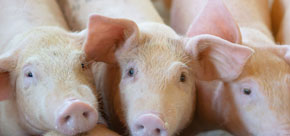Pigs Standards
HOUSING, SHELTER AND HANDLING FACILITIES Version 5.1 (modified)
Click to view
Key – Those standards which have greater significance (all other standards are normal)
Recommendation – Those which do not affect certification
New – A completely new standard which the member must now adhere to
Revised – A standard that has changed and requires the member to take some different or additional action to before
Upgraded – The standard has been upgraded to a Key standard or from a Recommendation to a full standard
Appendix – Referenced in ‘How you will be measured’. Indicates that additional information is provided in the Appendices, which are available at the end of each section.
PG.HF.1 Key
Housing must be constructed and maintained to provide a safe and secure environment for livestock
How you will be measured
PG.HF.1.a
PG.HF.1.b
PG.HF.1.c
PG.HF.2
Housing must be appropriately and effectively ventilated
How you will be measured
PG.HF.2.a
PG.HF.2.1
Contingency measures must be put in place during extreme weather* to minimise impact on pig welfare
*unusually hot or cold weather, wide fluctuations in external temperature, snow, severe wet weather, ventilation failure
How you will be measured
PG.HF.2.1.a
PG.HF.2.1.b
Extreme Weather Contingency Plan
PG.HF.2.3
Where there is insufficient self-ventilation and forced or automatic ventilation is used, there must be an alarm system in place to warn of failure
How you will be measured
PG.HF.2.3.a
PG.HF.2.3.b
Alarm check record
PG.HF.2.4
Back-up provision must be available in case of ventilation failure
PG.HF.3
Floors must be constructed and maintained in a manner that minimises risk of injury to pigs
How you will be measured
PG.HF.3.a
PG.HF.3.b
PG.HF.3.1 Key
Where concrete slatted floors are in use, current UK legislation on slot and beam widths must be adhered to
How you will be measured
PG.HF.3.1.a
PG.HF.4 Key
Conditions in housing must be maintained in a manner that ensures livestock are able to keep clean
How you will be measured
PG.HF.4.a
PG.HF.4.b
PG.HF.4.c
PG.HF.4.d
PG.HF.5
Lighting in housing must allow normal behaviours, rest and effective inspection of livestock
How you will be measured
PG.HF.5.a
PG.HF.5.b
PG.HF.5.c
PG.HF.5.d
PG.HF.5.e
PG.HF.6 Key
Feeding herd housing must be of sufficient size
How you will be measured
PG.HF.6.a
PG.HF.6.b
PG.HF.6.1 Key
Breeding herd housing must be of sufficient size
How you will be measured
PG.HF.6.1.a
PG.HF.6.1.b
PG.HF.6.1.c
PG.HF.6.1.d
PG.HF.6.1.e
PG.HF.6.2
Tiered cages are not permitted
PG.HF.6.3
Where self-locking individual feeding stalls are used, certain conditions must be met
How you will be measured
PG.HF.6.3.a
PG.HF.6.3.b
PG.HF.6.4
Pigs must always be able to see other pigs, except where the pig is isolated for veterinary reasons, or whilst sows/gilts are in farrowing pens
PG.HF.6.5
Where a balcony system is installed, it must meet scheme requirements
How you will be measured
PG.HF.6.5.a
PG.HF.7
Livestock must be kept in appropriate groups
How you will be measured
PG.HF.7.a
PG.HF.7.b
PG.HF.7.c
PG.HF.7.1 Key
Dry sows and gilts must not be held in tethers or routinely kept in stalls
How you will be measured
PG.HF.7.1.a
PG.HF.9
There must be appropriate facilities for livestock to give birth.
How you will be measured
PG.HF.9.a
PG.HF.9.1
Farrowing pens and crates must be of a sufficient length
How you will be measured
PG.HF.9.1.a
PG.HF.9.1.b
PG.HF.9.2
Sows must not enter farrowing crates more than 7 days prior to their expected farrowing date
PG.HF.9.3
It is recommended that where a temporary crating system is used the farrowing crate is opened-up to allow the sow to turn freely as soon as practicable after farrowing
PG.HF.9.4
Sows must not be kept in farrowing crates once they have finished suckling piglets
How you will be measured
PG.HF.9.4.a
PG.HF.9.4.b
PG.HF.9.5
Sows and gilts must be given suitable material to satisfy nest-building behaviour in at least the 24 hour period before expected farrowing
How you will be measured
PG.HF.9.5.a
PG.HF.9.5.b
PG.HF.9.6
Indoor loose farrowing pens must be designed appropriately
How you will be measured
PG.HF.9.6.a
PG.HF.9.6.b
PG.HF.10
Facilities must be available on-farm that enable the loading and unloading of livestock with minimal stress and risk of injury to livestock
How you will be measured
PG.HF.10.a
PG.HF.10.b
PG.HF.10.c
PG.HF.10.d
- Government guidance on keeping farm animals in extreme weather: https://www.gov.uk/guidance/keeping-farm-animals-and-horses-in-extreme-weather
- AHDB factsheets on heat stress:
– https://ahdb.org.uk/knowledge-library/heat-stress-indoor-pig-herds (indoor herds)
– https://ahdb.org.uk/knowledge-library/heat-stress-outdoor-herds (outdoor herds) - AHDB advice and useful guidance booklet on ventilating pig buildings: https://ahdb.org.uk/knowledge-library/ventilating-pig-buildings
- AHDB guidance on lighting for pig buildings: https://ahdb.org.uk/knowledge-library/lighting-for-pig-buildings
- AHDB guidance booklet – controlled environment for livestock: https://projectblue.blob.core.windows.net/media/Default/Pork/Documents/Controlled%20Environment%20%20for%20Livestock%20WEB
- European Reference Centre for Animal Welfare factsheet on nest building material: https://edepot.wur.nl/516953
- AHDB guidance on farrowing environment: https://ahdb.org.uk/knowledge-library/indoor-farrowing-environment (indoor)
More Standards
- HF.2.1 – Extreme Weather Contingency Plan is required on all units, including indoor and outdoor set-ups. It can be a standalone document or part of the Veterinary Health Plan.
- HF.4 – In exceptional circumstances, it may be acceptable for there to be no dry lying area temporarily, in order to mitigate heat stress, e.g. when misters/sprinklers are used as part of the Extreme Weather Contingency Plan
- HF.6.2 – For the purposes of the scheme, a cage is defined as an enclosure of bars and/or wires for keeping animals in. A tiered system, in which pigs are kept in 2 or more levels within the same airspace, is permitted provided the design meets the balcony system specification outlined in HF.6.5 and associated Appendix.
- HF.9.3 – The Defra Code of Practice states that temporary crating systems should usually be opened within 4 days of farrowing, unless there is an overriding health or welfare reason to alter this. However, further research and commercial experience is needed to identify the optimum time at which to remove confinement and to develop best practice around these systems.
- HF.9.5 – Acceptable nesting material includes, but is not limited to, wood shavings, shredded newspaper, straw, hessian sack/pieces, natural rope (ideally extending to the floor so the sow can push it along the floor).
